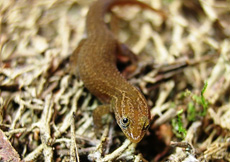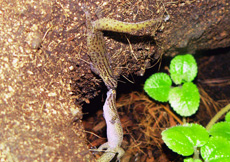Sphaerodactylus notatus
(BAIRD, 1859)
Distribution:
Sphaerodactylus notatus occurs in the Bahamas (Bimini, Andros, New Providence, Eleuthera, Long Island), Cuba (Las Tunas, Granma, Holguín, Santiago de Cuba, Guantánamo, Isla de la Juventud), Honduras (Little Swan Island), Hispaniola, Florida and Colombia. The subspecies Sphaerodactylus notatus amaurus is found in the Bahamas (Great Bahama Bank, Cat Island und San Salvador Island). Sphaerodactylus notatus atactus inhabits Cuba and was probably displaced to Great Inagua Island (Bahamas). Sphaerodactylus notatus exsul occurs on Little Swan Island (Honduras) and Sphaerodactylus notatus peltastes on the Little Bahama Bank.
Description:
The illustrated and described subspecies on this page is Sphaerodactylus notatus atactus from Cuba.
The geckos reach a maximum total length of 5.5 centimeters, with their tail accounting for half of their size. The dorsal scales are relatively large, strongly keeled and imbricately arranged. The head of Sphaerodactylus notatus is less sharp when compared with other representatives of the genus.
Both sexes are brown in color, which slowly turns in to yellow at the tail. From the tip of the snout extending laterally through the eyes and in the center of the head are black stripes, within the first third of the body the stripes fade in to the main coloring of the animal. The body is mottled with dark brown scales. The head varies in coloration per individual. There are individuals with severely contrasted patterns, as well as those in which almost all the pattern is missing. Females often have two eye spots centered on the back of the head. However they can also be absent. Ventrally Sphaerodactylus notatus is colored light brown, the throat is nearly white.
Young animals have the same coloration as the adults, but with significantly more contrast and a white tail tip, which is lost at the age of six months.
Habitat:
Sphaerodactylus notatus is a ground dweller, due to this it is found in the leaf litter, under stones, dead wood and plant material. The microhabitat for Sphaerodactylus notatus must be slightly damp, so the geckos prefer to be in partially shaded places and less in all day sun-exposed areas. The eggs of Sphaerodactylus notatus are found only at elevated positions in tree stumps and under loose bark of trees at altitudes of about one meter. Here it seems the temperatures and protection of the eggs are better.
In the province of Holguín Sphaerodactylus nigropunctatus granti can be found in the same habitat, in the province of Santiago de Cuba Sphaerodactylus notatus is syntopic with Sphaerdactylus torrei.
Husbandry and Breeding:
Sphaerodactylus notatus may be kept in small tanks with an edge length of 20 centimeters without difficulty. Keeping a single pair per terrarium is recommended, since even the females can be very aggressive with each other. However keeping them with a differently colored type of Sphaerodactylus such as Sphaerodactylus torrei or Sphaerodactylus nigropunctatus is no problem.
Illumination may be provided by small compact fluorescent lamps rated for daylight color. The terrarium should be illuminated for 12 hours in summer to help achieve the required daily temperatures of 26-28°C (79-82°F). Spot lamps are not a requirement and may even overheat the terrarium! The terrarium floor should consist of a soil and sand mixture for the substrate, a few pieces of bark and leaves laid flat help offer the geckos a place to hide. Upright pieces of bark are used as additional retreats and egg laying locations. A small bowl of water and crushed up cuttlefish bone completes the setup.
In order to achieve a relative humidity of 70% and to keep the substrate slightly moist, the terrarium should be misted once daily. They are fed twice weekly with small crickets, woodlice, springtails, small wax moths and their larvae. All food should be dusted with the appropriate supplements at every feeding.
In the breeding season the females lay about every three weeks a single egg in a suitable location, usually in bark or under leaves. The adult animals do not seem to bother their young. If possible, the eggs should still be removed and transferred to an incubator for better control. At temperatures around 26°C (79°F) the young emerge after 70 days with a total length of about 2.2 centimeters. They can be raised with the parents or in small groups in modified 1.3 liter household containers. There must be a sufficient supply of micro food, such as springtails and micro crickets. All food should be dusted with the appropriate supplements at every feeding. Within half a year the animals are already fully grown and can become further breeding pairs.
In order to allow the females an egg laying break, it should be observed that this species usually rests for about 3 months, during this time reduced illumination and lower temperatures should be maintained.
Sphaerodactylus notatus easily captivates you by its creeping locomotion and beautiful patterns. In the morning and evening, the animals are usually seen foraging for food. Furthermore they can be kept very well with other Sphaerodactylus species. It is a easy to keep gecko that I do not want missing from my collection!








